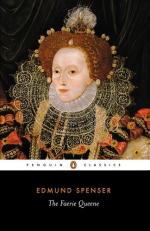432. FRESHEST FLORA, the goddess of flowers. She typified spring.
447. TO PROVE HIS SENSE, etc. To test his perception and prove her feigned truth.
449. THO CAN SHE WEEPE, then did she weep. Can here is the Northern dialect form for the middle English gan, past tense of ginnen, to begin, which was used as an auxiliary.
454. THE BLIND GOD, Cupid, Eros, or Amor, the god of love.
478. Like other knights of romance, e.g. Sir Galahad and Sir Gareth in Malory’s Morte d’Arthur, iii, 65, etc., the Redcross Knight does not yield to the temptation of the flesh, but overcomes it.
QUESTIONS AND TOPICS FOR STUDY
(Canto I)
1. Tell in your own words the story of this canto. 2. Which muse does Spenser invoke? 3. Who were the nine muses? 4. What is the difference between pastoral and epic poetry? 5. Illustrate by The Shepheards Calender and the The Faerie Queene. 6. Point out imitations of Homer, Vergil, Lucan, Statius, Ariosto, Tasso, and Chaucer. 7. Explain the reference to the religious questions and politics of Queen Elizabeth’s reign. 8. Where does Spenser use classical mythology—mediaeval legends? 9. What references to the Bible do you find? 10. Try to make a mental picture of the Knight—of Una—of Error—of Archimago. 11. Is Spenser’s character drawing objective or subjective? 12. Is the description of the wood in vii true to nature? Could so many trees grow together in a thick wood? 13. Study the Rembrandt-like effects of light and shade in xiv. 14. What infernal deities are conjured up by Archimago?
15. Paraphrase in your own language ll. 88, 106-107, 116, 267-268.
16. Explain use of of in l. 75. 17. What part of speech is wandering l. 114? to viewen l. 201? parse which l. 232; him and spend l. 233; you and shew l. 276. 18. Find examples of Euphuistic hyperbole in iv, of alliteration in xiv. 19. Explain the use and form of eyne, edified, afflicted, weeds, Hebean, impe, compeld, areeds, blazon, ycladd.
CANTO II
I. The Plot: Deceived by Archimago’s phantoms, the Redcross Knight suspects the chastity of Una, and flies at early dawn with his dwarf. He chances to meet the Saracen Sansfoy in company with the false Duessa. They do battle and Sansfoy is slain. Duessa under the name of Fidessa attaches herself to the Knight, and they ride forward. They stop to rest under some shady trees, On breaking a bough, the Knight discovers that the trees are two lovers, Fradubio and Fraelissa, thus imprisoned by the cruel enchantment of Duessa.
II. The Allegory: 1. Hypocrisy under a pious disguise is attractive to Holiness. Truth is also deceived by it, and shamefully slandered. Holiness having abandoned Truth, takes up with Falsehood, who is attended by Infidelity. Unbelief when openly assailing Holiness is overthrown, but Falsehood under the guise of Faith remains undiscovered. The fate of the man (Fradubio) is set forth who halts between two opinions,—False Religion (Duessa) and Heathen Philosophy, or Natural Religion (Fraelissa).




